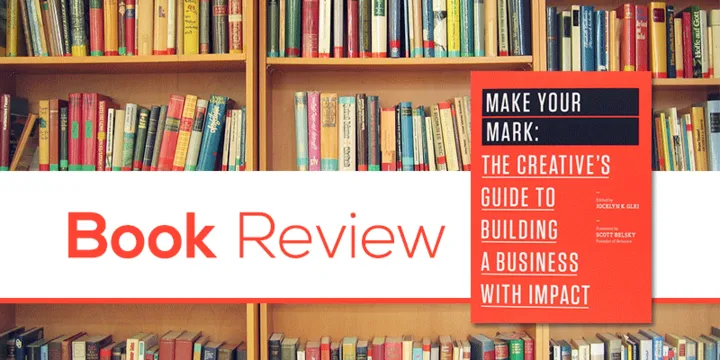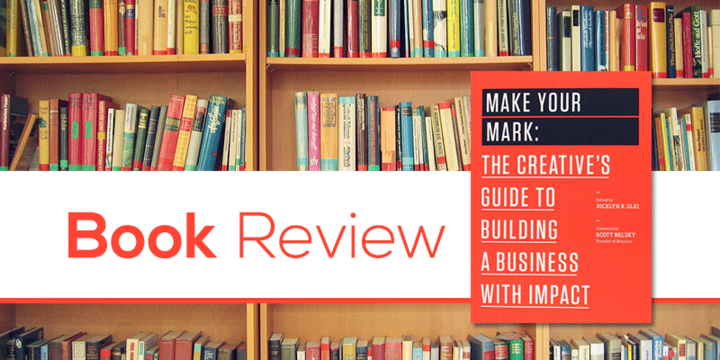Make your mark: startup tips from 21 founders and creatives
Entrepreneurship is one of the fastest routes for ambitious creative people to make business and social impact. Insights and tips from 21 founders and designers are offered in the book ‘Make your mark: the creative's guide to building a business with impact,’ edited by Jocelyn K. Glei.

Jocelyn K. Glei is Editor-in-Chief and Director of 99U, and curates the 99U Conference. Her other books are ‘Manage Your Day-to-Day’ and ‘Maximise Your Potential.’ The well-designed book makes for a quick and inspiring read, and features insights from Google Glass, Facebook, O’Reilly Media, Adobe, KPCB and others.
“Without great management and stewardship, creativity - like fireworks – will flash and then dim to dust. Creation must be made accessible for consumption. This is your real job. It takes struggle that you genuinely believe is worth the pain,” begins Scott Belsky in the Foreword. Scott Belsky is an entrepreneur, author, investor, and Adobe's Vice President of Products-Community. He is also Head of Behance, a leading online platform for creatives (acquired by Adobe in 2012). His earlier bestseller is ‘Making Ideas Happen.’
Here are my key takeaways from the 260-page book, clustered into four categories: purpose, product, customers and teams. For more on startup methodology and leadership, see my reviews of the related books The Lean Startup by Eric Ries and The Creator’s Code by Amy Wilkinson.
I. Defining your purpose
“The best businesses aren’t profit-driven or even product-driven; they’re purpose driven,” says Glei. They are about the need to make an impact, not just an IPO; about doing good and not just being fast.
“Impact justifies purpose. It fuels purpose,” says Keith Yamashita, founder of consultancy firm SY. Compassionate businesses are ones where personal and professional purposes are aligned. Introspection helps distill a sense of purpose into a compelling vision.
“The problem you are solving should be a constant guiding light,” says Emily Hayward, Founding Partner at Red Antler. Founders and creators should focus on an emotional solution that connects with customers and employees at their core.
Founders should repeatedly ask themselves a series of questions. Why are we here? If we disappeared, who would miss us and why? What business are we really in? What are we willing to sacrifice? How can we experiment better? “Questions are the means to search,” explains Warren Berger, author of ‘A more beautiful question: the power of inquiry to spark breakthrough ideas.’
To make this purpose a reality, founders need to craft a culture with a “responsive operating system,” advises Aaron Dignan, CEO of Undercurrent. This helps them start small, grow fast and dominate markets, e.g. Twitter, Facebook, Google. In a “lean, mean, learning machine,” employees feel comfortable with the unknown and are willing to experiment, fail and learn.
“Emotionally intelligent stories” are needed to keep companies on the right track, says Tim O-Reilly, founder of O’Reilly Media. “We live in a world of stories that are really our maps of how to think about the world,” he explains.
II. Building your product
Enthusiasm of the creators and usability of the product are twin ideals behind great product development. First try to get one product right, then think about a portfolio or range, advises Andy Dunn, CEO of Bonobos, drawing on the example of Spaly Pants which began with one successful pant type then scaled up to a whole range along with e-commerce delivery and guideshops.
Great product creators are not just makers but curators of great user experiences, explains Adobe’s Scott Belsky. Simplicity and a good hook for users are important success factors. “The devil is in the default,” cautions David Morin, CEO of Path; the default experience is the bare bones experience without additional features and customisation.
The experience of learning and scaling should be meaningful and fun; the iterative process is as important as the prototypes and products, advises Sebastian Thrun, CEO of Udacity. Founders need to develop a growth mindset and overcome the fear of failure along the way; failure is a systematic part of the innovation process.
Design is more than a marriage of function and form, it is also about continuous experience and interaction in the digital world, observes Julie Zhou, who leads a design team at Facebook. Designs should build in flexibility and links to familiar metaphors while also keeping in mind broader ecosystem changes, eg. the early shift away from directories to search (Yahoo, Google), but the merit of the directory approach in products like DropBox. “Design is expanding beyond what our eyes can see and beyond what our fingers can touch on a flat screen,” explains Zhou.
III. Serving your customers
Founders need to earn customer trust and loyalty the hard and long way, through commitment, service, conversation and authenticity even in the face of mistakes. Glei explains, the question is not ‘Will the customer come?’ but ‘Are you ready to serve them?’
“The absolute privilege of our time is that we can hear our users talking – and like never before, we can listen. So listen,” says Jane Ni Dhulchaonintigh, CEO of Sugru. Put your prototypes into your users’ hands, start a genuine conversation with them, and let them be your ambassadors.
“Strategic giving” and volunteer activity along with business drive are useful ways of recruiting an “army of allies,” says Chris Guillebeau, author of ‘The $100 Startup’ (see my book review). “Reciprocity is a powerful practice. The more you give away, the stronger the bond you will create,” he adds.
“Listen to your customers, no matter how much it slows you down,” says Sean Blanda, editor of 99u. Only when you listen to, understand and remove your customer pain points are you ready to scale, explains Blanda, drawing on the example of AirBnB.
“People have extremely sensitive BS detectors these days,” jokes Neil Blumenthal, CEO of Warby Parker. Brands need to tune in to the conversations customers are having about them on social media. Blumenthal’s eyewear company listens to its customers’ needs and priorities its messages accordingly: looks first, price second, customer service third and social mission fourth.
“Invite your customers into your story. Great stories change the way we think,” says Craig Dalton, Founder of SF Made. Great stories inspire us, start conversations and build connections; brand successfully using this strategy include Patagonia (adventure, environmental conservation) and Nest (home control, smart technology).
“A culture of tiny kindnesses isn’t just good for the world. It’s good for business,” says Shane Snow, chief creative officer of Contently. Examples include tattoo company Tattly’s free giveaways with each purchase and its creative humorous messaging; Google Doodles; and NextJump’s smile-inducing logo hacks.
IV. Leading your team
“The true leader’s job is to help everyone around them do their job better,” says Glei. Managing and leading a team towards a common goal is a rare and valuable skill worth cultivating. “Management is among the most noble of professions,” in the words of Clayton Christensen, author of bestsellers like ‘Innovators’ DNA’ (see my book review).
Leadership isn’t about power or control but serving. “Servant leadership” is the only sane way to run a company, says Richard Armstrong, General Manager at Fog Creek Software. “When good people start learning about servant leadership, something wonderful happens,” he adds.
Joel Gascoigne, CEO of Buffer, offers useful tips for leaders to create a culture of trust via transparency. Share information about deals, meetings and even salaries. Allow for open feedback across all employees. Have regular meetings and share periodic reports online and offline. (See also my reviews of the books ‘Disciplined Entrepreneurship’ by Bill Aulet and ‘Startup Leadership’ by Derek Lidow.)
The transition from creator or maker to a manager or leader can be a big challenge. “Creatives are driven by passion, by integrity, and by quality,” says John Maeda, design partner at Kleiner Perkins Caufield & Byers. However, management can also be seen as a new kind of art for creatives, though the timelines are longer and the gratification is different. Creatives also can manage ambiguity much better than anyone else.
As a company scales and expands, the sense of direction and clarity need to be spelt out via effective communication, otherwise the most precious resource is lost: time. “When the makeup of your team is constantly changing, you lose the continuity and institutional knowledge so important to maintaining quality and consistency,” cautions William Allen, Senior Director of Behance. He recommends all-hands meetings, public record keeping, and workplace shuffling as ways of ensuring cohesion.
Employees should feel engaged and empowered. “I believe all humans have the potential for acts of greatness. I call it the everyday superhero within,” says David Marquet, author of ‘Turn the ship around.’ Company cultures need to have a good combination of “nudge” and “push” via distributed decision making.
The book ends with a call to action by marketing guru Seth Godin. Don’t wait for the perfect moment to prepare your perfect product and launch it for the perfect audience. “If you wait until you are ready, it is almost certainly too late,” cautions Godin.











